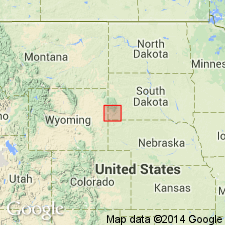
- Usage in publication:
-
- Minnekahta limestone*
- Modifications:
-
- Named
- Biostratigraphic dating
- Dominant lithology:
-
- Limestone
- AAPG geologic province:
-
- Chadron arch
- Powder River basin
- Williston basin
Summary:
Named as a formation for the region near the hot springs, originally known as the "Minnekahta" by the [Dakota] Indians, which is a typical locality. The springs rise through crevices in the formation just west of the town of Hot Springs, Fall River Co., on Chadron arch. Type section not designated. Extends continuously around the Black Hills [SD and WY on the Chadron arch, and in Williston and Powder River basins]. Was known in previous geological reports as Purple limestone. Is uniform in character, being a thin-bedded, light-colored limestone containing magnesia, and more or less clay as an impurity. The general appearance of the formation is always slightly pinkish with a tinge of purple. Gives five representative measurements of the thickness in the Black Hills region, ranging from 28 to 50 ft. Thickness at Hot Springs given as 50 ft. Overlies Opeche formation (new); overlain by Spearfish formation. Assigned a Permian age based on fossils found at several points, most abundantly in the railroad cut about 2 mi north of Minnekahta. [This locality subsequently given as 4 mi north of Minnekahta (or in sec 29, T6S, R4E, Custer Co., SD on Chadron arch) by Darton, 1904, Edgemont folio, SD--Nebraska: U.S. Geological Survey Geologic Atlas of the United States, folio 108, p. 3.]
Source: GNU records (USGS DDS-6; Denver GNULEX).
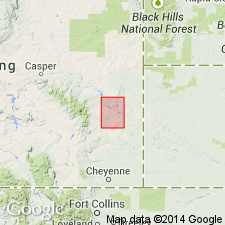
- Usage in publication:
-
- Minnekahta formation*
- Modifications:
-
- Areal extent
- Overview
- AAPG geologic province:
-
- Denver basin
Summary:
Extended from the Black Hills area, SD to the Hartville area, Platte Co, WY in the Denver basin. Lies conformably on the Permian? Opeche Shale; also extended from the Black Hills into the Hartville area. Consists of 20 ft of fine-grained gray limestone that weathers into slabs. Forms series of low hogbacks. Crops out in northwest part of geologic map. Columnar section. Underlies Permian Spearfish sandstone which is extended into map area. Of Permian? age.
Source: GNU records (USGS DDS-6; Denver GNULEX).
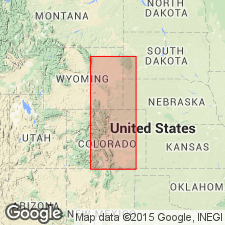
- Usage in publication:
-
- Minnekahta limestone*
- Modifications:
-
- Overview
- AAPG geologic province:
-
- Williston basin
Summary:
Extends name to the Hartville uplift, Platte Co, WY in the Denver basin, where it is overlain by Spearfish formation and underlain by Opeche shale. Also identified as a distinctive bed in near base of Chugwater formation (new) in Bighorn Mountains, WY, and on the north side of Casper Mountain, WY in the Powder River basin; on the east side of the Laramie Range, WY and on the east side of the Front Range, CO in the Denver basin. Correlates with Minnekahta of the Black Hills, SD of the Williston basin. Is Permian in age.
Source: GNU records (USGS DDS-6; Denver GNULEX).

- Usage in publication:
-
- Minnekahta limestone
- Modifications:
-
- Areal extent
- AAPG geologic province:
-
- Chadron arch
Summary:
Name extended southward in the subsurface into northeastern NE on the Chadron arch. Identified in the Duthie well, sec 33, T35N, R47N, Dawes Co, NE for reddish limestone at depths 1,825-1,850 ft. Overlain by Spearfish formation; underlain by Opeche shale. Permian in age.
Source: GNU records (USGS DDS-6; Denver GNULEX).
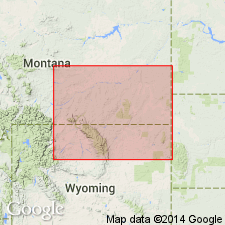
- Usage in publication:
-
- Minnekahta limestone
- Modifications:
-
- Areal extent
- AAPG geologic province:
-
- Williston basin
Summary:
Used name in southeast MT [southern part of the Williston basin] in the Montana-Dakota Utilities Co., No. 1 Northern Pacific Railroad Co. well, sec 17, T4N, R62E, Fallon Co., MT for limestone in the interval 5,463 to 5,490 ft. Overlain by Spearfish formation; underlain by Opeche formation. Is Permian in age.
Source: GNU records (USGS DDS-6; Denver GNULEX).
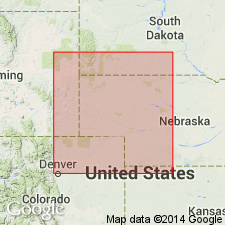
- Usage in publication:
-
- Minnekahta limestone
- Modifications:
-
- Revised
- Areal extent
- AAPG geologic province:
-
- Denver basin
- Powder River basin
Summary:
Assigned Minnekahta limestone to the Phosphoria group [intent to designate as a group not stated]. Recognized in sections from Owl Canyon, Larimer County, Colorado, north to the Laramie Range (Denver basin), and as far north as La Bonte Post Office [sec. 5, T. 29 N., R. 72 W.] Converse County, Wyoming (Powder River basin). Shown extending across Denver-Julesburg basin (Denver basin). Underlies the Glendo shale (new); overlies Opeche shale. Age is Permian. Report includes measured sections.
Source: Modified from GNU records (USGS DDS-6; Denver GNULEX).
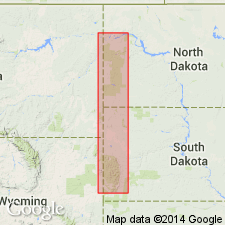
- Usage in publication:
-
- Minnekahta limestone
- Modifications:
-
- Areal extent
- AAPG geologic province:
-
- Williston basin
Summary:
Extends Minnekahta limestone to Nesson anticline in central part of Williston basin, Williams County, North Dakota. Age is Permian.
Source: Modified from GNU records (USGS DDS-6; Denver GNULEX).
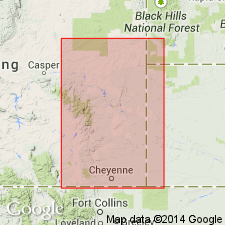
- Usage in publication:
-
- Minnekahta limestone tongue
- Modifications:
-
- Overview
- Areal extent
- AAPG geologic province:
-
- Powder River basin
- Wind River basin
- Green River basin
Summary:
States that Sybille tongue of Phosphoria formation of Thomas (1934, AAPG Bull., v. 18, no. 12) is the Minnekahta [limestone, of the Black Hills]. Advises that the name Sybille be dropped in favor of Minnekahta tongue of Phosphoria formation in Converse, Natrona, and Albany Counties, Wyoming [Powder River, Wind River, and Greater Green River basins]. Overlies a red-bed unit correlated with Opeche formation of the Black Hills, and lower part of Satanka formation of southeast Wyoming; underlies a red-bed tongue of either Satanka or Chugwater formation of central and southeast Wyoming. Age is Permian.
Source: Modified from GNU records (USGS DDS-6; Denver GNULEX).

- Usage in publication:
-
- Minnekahta limestone tongue
- Modifications:
-
- Age modified
- Biostratigraphic dating
- AAPG geologic province:
-
- Wind River basin
Summary:
May be as old as Leonardian (early middle Permian) based on specimens of the nautiloid, COELOGASTEROCERAS MEXICANUM, collected from the unit in the Shirley Mountains [sec 1, T24N, R82W, Carbon Co, WY in the Greater Green River basin]. Is a tongue of the Phosphoria formation.
Source: GNU records (USGS DDS-6; Denver GNULEX).
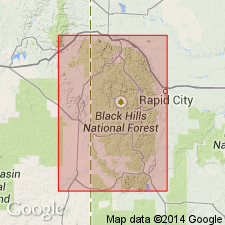
- Usage in publication:
-
- Minnekahta formation
- Modifications:
-
- Redescribed
- AAPG geologic province:
-
- Williston basin
- Powder River basin
- Chadron arch
Summary:
Both lithologic appearance and insoluble residues indicate a four-fold division throughout the Black Hills, on Chadron arch and in Williston and Powder River basins, including (descending): an upper pure zone, upper shaly zone, lower pure zone, and lower shaly zone. Percentages of insolubles appear to increase to the south. Is Permian in age.
Source: GNU records (USGS DDS-6; Denver GNULEX).

- Usage in publication:
-
- Minnekahta limestone
- Modifications:
-
- Overview
- AAPG geologic province:
-
- Williston basin
Summary:
Named used in western ND for limestone, cream-, pink-, and purple-mottled, chalky to sublithographic, slightly argillaceous, anhydritic locally, 0-50 ft thick. Deposited in shallow water. Unconformable with overlying Spearfish formation; conformable with underlying Opeche formation. Is Permian in age.
Source: GNU records (USGS DDS-6; Denver GNULEX).
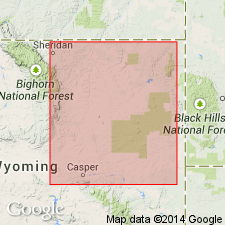
- Usage in publication:
-
- Minnekahta limestone member
- Modifications:
-
- Overview
- AAPG geologic province:
-
- Powder River basin
- Wind River basin
Summary:
Considered a member of Goose Egg formation in the subsurface of the Powder River basin, WY. Most extensive member of Goose Egg formation in the Powder River basin, although it is absent in the northwestern part in Sheridan and adjacent parts of Johnson and Campbell Cos, WY because of nondeposition. Overlain conformably by Glendo shale member in the southern part of the basin, or by an unnamed shale member in the northern part of the basin. Underlain conformably by Opeche shale member. Map shows distribution. Cross sections show correlation in ten wells in the basin, and in two wells in Natrona Co, WY in the adjacent eastern part of the Wind River basin. Permian in age.
Source: GNU records (USGS DDS-6; Denver GNULEX).
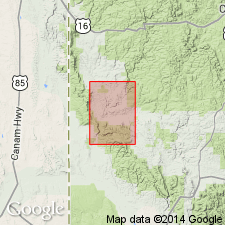
- Usage in publication:
-
- Minnekahta Limestone
- Modifications:
-
- Revised
- AAPG geologic province:
-
- Chadron arch
Summary:
Divided locally into units 1 to 4, ascending. Unit 1, about 4 ft thick, consists of alternating thin beds of pure limestone. Unit 2, about 15 ft thick, consists of layers of light-gray limestone alternating with layers of reddish-brown limestone; contains zones of ellipsoidal calcite concretions. Unit 3, 3-5 ft thick, consists of dark-reddish-gray limestone with laminae of red siltstone. Unit 4, about 15 ft thick, is thinly stratified, dominantly reddish-gray limestone, mottled medium gray. Lists gastropods, pelecypods, and a fragment of a fish collected from the formation. Is Permian in age.
Source: GNU records (USGS DDS-6; Denver GNULEX).
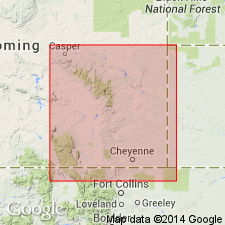
- Usage in publication:
-
- Minnekahta Limestone Member*
- Modifications:
-
- Revised
- Overview
- AAPG geologic province:
-
- Green River basin
Summary:
Reduced in stratigraphic rank in Carbon and Albany Cos, WY, Greater Green River basin, and assigned to the Goose Egg Formation as one of eight members. Thins from about 50 ft thick in the Black Hills to 30 ft thick in the northern Laramie Range to less than 10 ft thick in the south half of the Laramie basin to less than 5 ft thick at Lodgepole Creek in the southern Laramie Range. Intertongues with Franson Member of Park City Formation in central WY. Overlies Opeche Shale Member, newly assigned to Goose Egg. Underlies Glendo Shale Member, newly assigned to Goose Egg. Correlates with Blaine Formation of KS and NE. Composed of thin even parallel-bedded and laminae of finely crystalline pink- to purple-gray dolomitic limestone, some interstratified purple-red claystone in the lower part. Becomes increasingly gypsiferous southeastward. Early Permian age.
Source: GNU records (USGS DDS-6; Denver GNULEX).
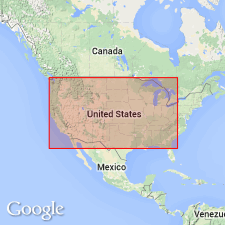
- Usage in publication:
-
- Minnekahta Limestone*
- Modifications:
-
- Overview
- AAPG geologic province:
-
- Williston basin
- Powder River basin
- Chadron arch
- Green River basin
- Denver basin
- Wind River basin
- Bighorn basin
Summary:
Used in formational sense (Minnekahta Limestone) in western SD, western ND, southeastern MT, and northeastern WY, in Williston, Powder River, and Denver basins, and on Chadron arch. Is a member of Satanka Shale in southeastern and south-central WY, in Greater Green River basin. Is known as Minnekahta Limestone Member of Goose Egg Formation in central WY, in Wind River and Bighorn basins. Shows correlations with units in nearby areas. Is Middle Permian (Leonardian) age.
Source: GNU records (USGS DDS-6; Denver GNULEX).
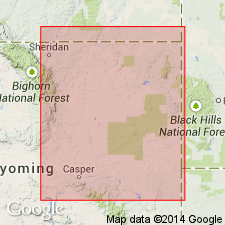
- Usage in publication:
-
- Minnekahta Limestone Member*
- Modifications:
-
- Areal extent
- AAPG geologic province:
-
- Powder River basin
Summary:
Goose Egg Formation identified in the subsurface of the Powder River basin in WY and MT where it unconformably overlies Minnelusa Formation and underlies Chugwater Formation. Goose Egg divided into (descending) an unnamed upper part, Minnekahta Limestone Member, and Opeche Shale Member. Of Permian age. [This nomenclature shown on 22 cross sections in this OC series.]
Source: GNU records (USGS DDS-6; Denver GNULEX).
For more information, please contact Nancy Stamm, Geologic Names Committee Secretary.
Asterisk (*) indicates published by U.S. Geological Survey authors.
"No current usage" (†) implies that a name has been abandoned or has fallen into disuse. Former usage and, if known, replacement name given in parentheses ( ).
Slash (/) indicates name conflicts with nomenclatural guidelines (CSN, 1933; ACSN, 1961, 1970; NACSN, 1983, 2005, 2021). May be explained within brackets ([ ]).

